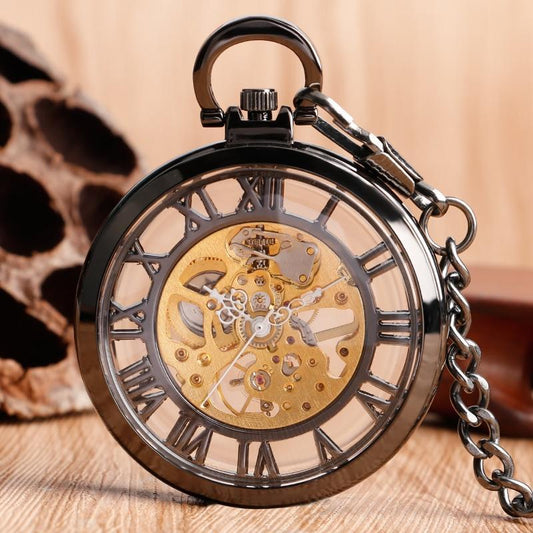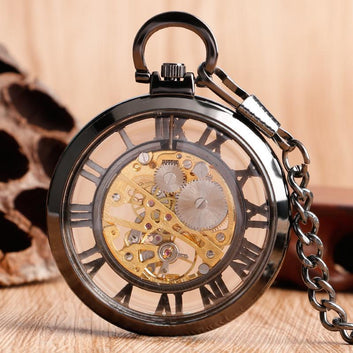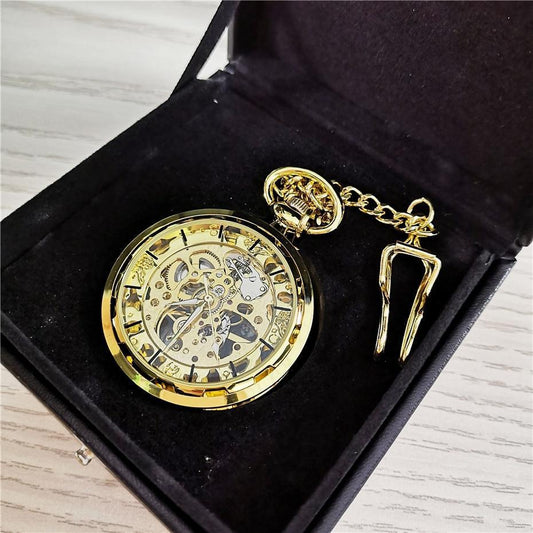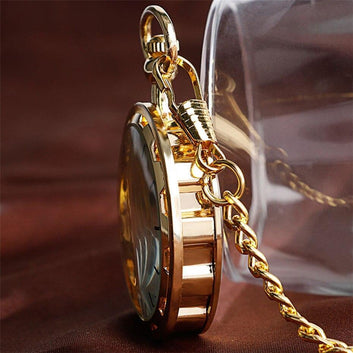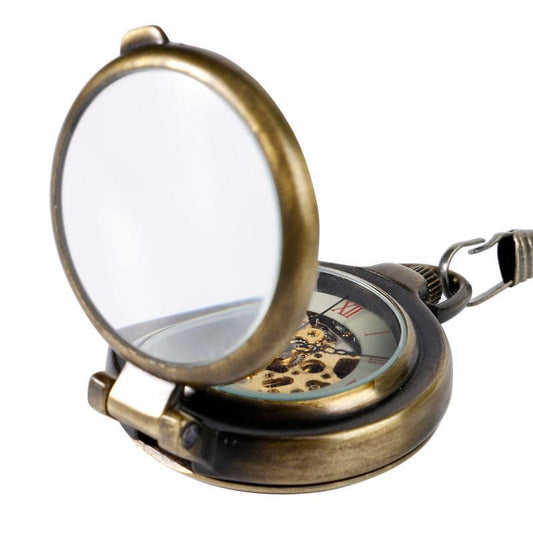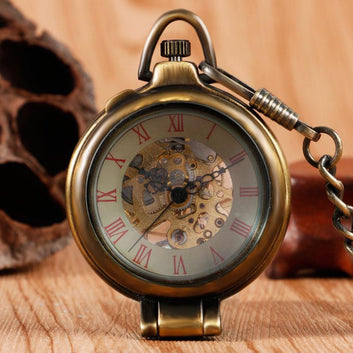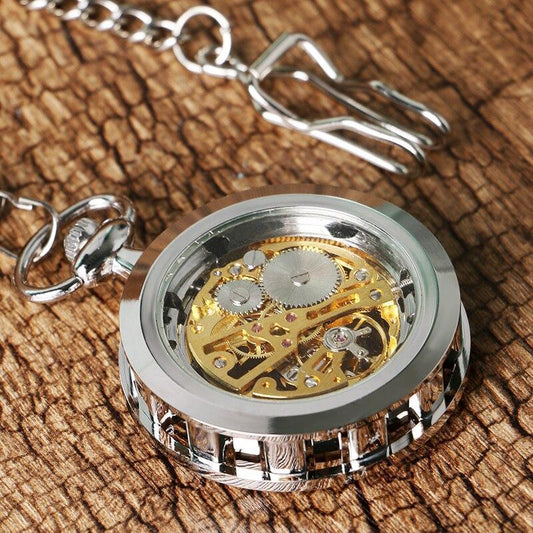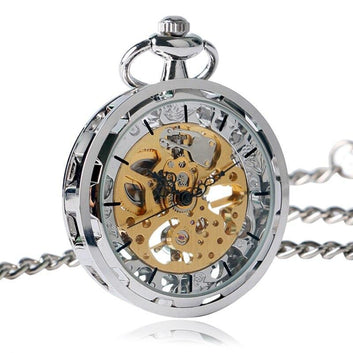- Featured
- Best selling
- Alphabetically, A-Z
- Alphabetically, Z-A
- Price, low to high
- Price, high to low
- Date, old to new
- Date, new to old
Skeleton Pocket Watch
Skeleton pocket watches facts
The Skeleton pocket watches are graceful and ever-elegant vintage timepieces that are to be had these days. If you are seeking out a selected kind of antique chronometer, then the Skeleton pocket watch collection might be one of every kind to make an impression at any special event. These vintage watches are often used in steampunk cosplays, worn on the vest fob, leather strap, jacket, or waistcoat. This retro timepiece can have several types of watch movements. The most common movements are the manual movement, the automatic movement, fusee and chain driven, or even the spring-driven.
These vintage watches with skeletonized dials have been used in film and television. It was often used by celebrities like James Dean, Elvis Presley and others. Additionally, it was also used by many villains like The Joker in the Batman movies.
However, before you buy one of these vintage watches, you need to know the characteristics of a skeleton pocket watch. These watches with skeletonized dials are not cheap. They are expensive and delicate and they require extra care to prevent damage. This is why you need to know the following.
There are three types of skeleton pocket watches:
- Pocket watch with lever movement (1870-1910)
- Pocket watch with pin lever movement (1860-1900)
- Pocket watch with pin wheel movement (1850-1900)
The first type is the most common type of skeleton pocket watches found today. These timepieces were produced from 1870 to 1910. It has a lever escapement mechanism and its case is usually made from gold or silver. It also has a hand-painted or printed dial that features Roman numerals or Arabic numerals. Its hands are also hand-painted and usually made of gold or silver.
The second type is similar to the first type except that it has a pin lever escapement mechanism instead of a lever escapement mechanism. This type was produced from 1860 to 1900. Its case is usually made from gold or silver too but it can be found in other materials like platinum, bronze or brass. Its dial and hands are usually made from white enamel painted with Roman numerals, Arabic numerals and fancy scrolls.
The third type is the most rare of all skeleton pocket watches because these were produced only in 1850-1900. It also has a pin wheel escapement mechanism and its case can be made from gold, silver, platinum or bronze but not brass because brass is too hard to work with when making parts for this watch. The dials of these watches are usually enamel painted with Arabic numerals while the hands are either blued steel or gilt steel. This type also has a very unique crown which is made from gold or silver and is shaped like a medieval knight's helmet. The glass of this watch is also made from special material called 'rock crystal'. This rock crystal glass is very hard to work with and the manufacturing process for it was only invented in 1851 by Louis Vatelot, a French scientist.
The fourth type of skeleton pocket watch has a lever escapement mechanism and its case, dial and hands are all made from gold or silver. Its case can either be round or oval.
This type of watch also has a special movement which was invented by Louis Audemars in 1842; it is called the Audemars movement. This movement uses two separate springs to drive the watch instead of one spring as used in other watches. The first spring drives the train wheel directly while the second spring drives the escapement wheel indirectly through an intermediate wheel called an 'escapement wheel'. This design reduces friction on the escapement and increases the accuracy of the watch. The lever escapement is also very sensitive and requires a skilled watchmaker to repair it.
The Audemars Piguet Royal Oak was designed by Gérald Genta and released in 1972. It has an Audemars movement with a lever escapement and its case is made from gold or platinum. Its dial is made from gold, silver or platinum and its hands are usually made from gold, silver, or platinum. This type of skeleton watch is considered to be the most complicated design for a skeleton watch as it contains over 300 parts. It usually has a tourbillion mechanism which makes it even more complicated to manufacture than other skeleton watches as tourbillions are very hard to make with high precision. The tourbillion mechanism used in this watch also makes it very expensive as the components for it have to be machined from solid metal blocks using special tools that were invented specifically for this purpose by Audemars Piguet.
The skeleton watches that are being sold today are extremely accurate as they contain many high-precision parts. They can also be very expensive as they require a lot of time and effort to build. The watches that have tourbillion mechanisms in them are usually the most expensive due to the difficulty of making the tourbillion mechanism and its components.
Watch movement specificities
What is a Watch Movement?
Automatic movement
Mechanical movement
Automatic or Mechanical?
How are Watches Measured?
Features
-
From antique silver pocket watch styles featuring tricky skeleton designs to ultra-present day chrome options, the skeleton silver pocket watches have a style to suit absolutely everyone and any occasion. Keep it simple with open face designs, or choose an engraved double hunter pocket watch - ideal either as a gift or as a deal with for your self skeleton pocket watch by way of are an incredible piece of horology for some reasons.
-
Firstly, there’s that alluring skeleton dial, which is quite spectacular. It permits a full show of the tricky internal workings. There’s not anything pretty as hypnotic as looking time tick on a mechanical watch. You’ll additionally fall in love with the comparison of the internal gold mechanics with the sleek black case.
-
Thirdly, it’s a mechanical movement, which is essential for any devoted watch wearer. While quartz is convenient, nothing beats the giant history and history that comes with a mechanical watch.
-
This pocket watch could make a terrific present for a husband, son, or grandparent. Suppose you’re trying to treat yourself to a unique timepiece to mark an expert or personal milestone.
A Guide to Buying a Skeleton Pocket Watch
When you think of a skeleton pocket watch, you probably think of an old, outdated timepiece. These days, skeleton watches are more popular than ever! That’s because they’re a great way to show off your love of fine watches and a great value for the money. Like other types of pocket watches, skeleton pocket watches are available in a variety of styles and prices. Like other types of pocket watches, you can easily find a skeleton pocket watch that suits your style and price range. Still not sure where to start your search? Keep reading for everything you need to know about buying a skeleton pocket watch.
What is a Skeleton Pocket Watch?
The skeleton pocket watch is a mechanical watch with a skeleton dial. The skeleton dial is a blank piece of metal, with the hands and markers on a separate piece of metal that sits next to the dial. The skeleton dial allows the skeleton watch to show the current time without a dial cover. The skeleton watch is an open-face watch, meaning that the watch case is transparent. This allows you to see the gears and wheels inside the watch. The skeleton
the watch is also called an open-face watch or a transparent watch. The open-face watch has a clear or transparent case that allows you to see the gears inside. This is why the skeleton watch is sometimes called a “transparent watch.”
What Does a Skeleton Pocket Watch Look Like?
Skeleton pocket watches come in all shapes and sizes, so it’s important to know what to look for. First, you’ll come across skeleton pocket watches with a fixed date. Fixed date skeleton watches have a date wheel that only goes one way, from the current date to the date you set it to. You’ll also come across open-face skeleton watches, which are open-face watches with a dial that has hands and markers. These watches are either swiss or chronograph models. You’ll also come across skeleton pocket watches with a dial that rotates.
What Does a Skeleton Pocket Watch Do?
To tell time on a skeleton pocket watch, you have to know how each part of the watch works. First, the hands of a skeleton watch don’t indicate the hours and minutes. Instead, they indicate the “seconds hand,” the “minute hand,” and the “hour hand.” For example, the second hand is usually positioned at the 6 o’clock position. The minute hand is usually positioned at the noon position, and the hour hand is usually positioned at the 6 o’clock position. The hands-on skeleton watch simply indicates the number of seconds, minutes, and hours that are currently elapsed. The second hand on a skeleton watch is usually used to indicate the time until the next second, whereas the hour hand is usually used to indicate the time until the next hour. The minute hand is usually used to indicate the time until the next minute.
How to Buy a Skeleton Pocket Watch
When you’re ready to buy a skeleton pocket watch, there are a few things you’ll want to keep in mind. The first is to know what you’re looking for. If you’re new to skeleton watches, it might be helpful to know the different types you can buy. Once you know what you’re looking for, you’ll want to start searching. You can search online or in brick-and-mortar stores. When you do find a skeleton pocket watch you like, you’ll want to take it to a jeweler that has a watch repair bench. This way, you can let the jeweler check the movement of the watch and make sure it’s working properly. When you’re ready to buy, you’ll want to do your research first. This way, you’ll know what to look for and what to avoid when you’re buying.
Finding the Right Skeleton Watch for You
As with any type of watch, it’s important to know what you like and what you don’t like in a watch. First, take note of what you wear most often on your wrist. Are you most likely to wear a watch that has boldface or a more subdued face? Do you prefer a watch with a leather or canvas strap? Once you know what you like most about watches, you can start looking at skeleton pocket watch models. Once you’ve narrowed down the models you like,
start looking for them on online retailers. Online retailers often have a large selection of skeleton pocket watches, so you’ll have no trouble finding a model you like.
On the Road to the Buy
It’s important to remember that buying a watch is a big investment. You want to make sure you buy the right watch for yourself and your lifestyle. Before making a purchase, remember to do your research. This means reading reviews and looking at the different models and types of skeleton pocket watches that are available. Once you’ve done your research, you can start looking at buying. Remember, when you buy a new watch, you want to make sure you buy it from a high-quality retailer. This means buying from an authorized dealer or an authorized retailer. Buying from an authorized dealer or an authorized retailer ensures you buy a high-quality watch. It also ensures the watch is serviced correctly and is running correctly.
Conclusion
Now that you know everything you need to know about buying a skeleton pocket watch, it’s time to buy one! There are a ton of options out there, so make sure you do your research before making a purchase. Once you’ve found the right watch, make sure you buy from a high-quality retailer. This means buying from an authorized dealer or an authorized retailer.

